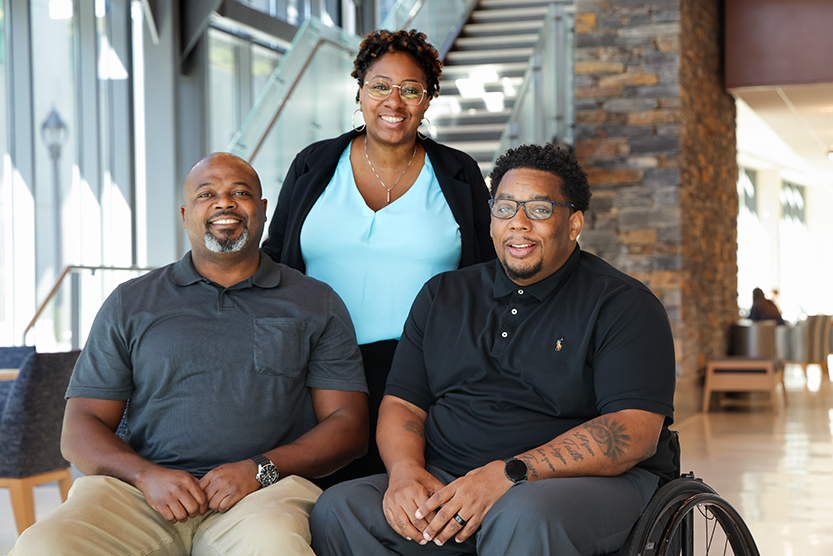
Surviving Gun Violence
Nearly 43,000 people died of gunshot wounds in the United States last year. But measuring gun violence by deaths alone misses the bigger picture: most people who are shot manage to survive their wounds.
At Duke University Hospital, where 355 people were treated for gunshot wounds in 2022, trauma surgeons and health care providers have expanded their focus to what happens next for those they save.
Beyond the initial medical emergency care to fix torn bodies, the road to healing is long and arduous. Rehabilitative care, including physical and occupational therapy, mental health support, and social reintegration, become crucial to recovery.
Yet, new research by the Duke University School of Medicine shows when gunshot wound patients, particularly poor and Black and Hispanic patients, are ready to leave the hospital, they face unequal access to the post-acute care that can help them rebuild their lives.

“These patients often come to us with multiple injuries,” said Suresh Agarwal, MD, chief of the Division of Trauma, Acute and Critical Care Surgery at Duke University Hospital. “Even young, previously healthy individuals require weeks to months of post-discharge care to regain basic skills like walking and eating.”
Race, insurance status, even age, predicts discharge destination. According to data, Black and Hispanic patients and those with Medicaid are less likely to be admitted to a skilled nursing facility or rehab center, and instead are often sent home with home health care which may not be equipped to handle complex needs.
Doctors believe the limited access to skilled nursing facilities stems from both patient insurance status and a reluctance to accept those who have experienced violence.
“Because patients are victims of violence, (facilities) are worried violence is going to come to their location,” said senior study author Krista Haines, DO, assistant professor of surgery and population health researcher at Duke. “So, the only place we can send them is home.
“We’re sending them home where they’re unlikely to be able to take care of themselves and we’re not sure someone is going to show up to take care of them,” if the home care agency considers the neighborhood unsafe.
There are heartbreaking losses to gun violence, but the surgeons estimate 70% to 80% of those with gunshot wounds survive. Survivors may face lifelong consequences such as paralysis or traumatic brain injuries, which is where post-acute care becomes crucial but for many remains out of reach.
"Even though these survivors have not lost their life to gun violence, they are at risk of losing their livelihood.”
- Anthony Eze, MD, MPH
The lack of equal access to post-acute care often results in some patients staying longer in hospitals when they could be receiving care in more cost-effective settings.
These extended hospital stays create a ripple effect, straining resources and potentially causing delays in critical care for other patients. “Residents and others were alarmed by the long stays and prompted us to examine ‘Just how big of an issue is this?’” said the trauma surgery chief.
Survivors Struggling to Heal
Anthony Eze, MD, a general surgery resident at Duke University Hospital, is among those researching the issues so often overlooked in the aftermath of gun violence.
He’s inspired by the survivors he sees struggling to heal, including one patient who endured a gunshot wound that resulted in a leg amputation.
The patient spent 55 days in the hospital while case managers searched for a rehab facility willing to accept him. His family visited as often as they could afford the trip to the Durham hospital. The patient was the breadwinner of the family, Eze recalls, so the weeks spent out of work in the hospital compounded family financial pressures and delayed his recovery.
Even after discharge, the patient repeatedly visited the emergency department for pain management and wound care.
“That’s not a story that’s unique to him, and likely not unique to our hospital,” Eze said. “Many times, people who are victims of gun violence have difficulty getting access to the rehabilitation facilities that they need. Even though these survivors have not lost their life to gun violence, they are at risk of losing their livelihood.”
Eze spearheaded the recent study on disparities in post-acute care, which also proposed solutions. Among them were employing pseudonyms, giving patients a different name to shield their identities and safeguard them from additional harm when admitted to skilled nursing facilities; and recruiting home health workers from the communities where gunshot victims are affected.
Offering resources is just the start. Truly supporting gunshot survivors demands a comprehensive approach, Agarwal said, that entails conducting additional studies to understand the barriers to post-acute care and allocating money for research aimed at tackling gun violence as a public health crisis.
“It’s about more than treating injuries, but ensuring that all survivors have a fair chance at healing and rebuilding their lives,” Haines said.
An Unequal Path to Recovery After Gunshot Wounds
The Problem: Gun violence is a major public health issue, especially in underserved communities of color. While death tolls often grab headlines, many survivors face long-term challenges. A study in the February issue of the Journal of Surgical Research examined whether race and insurance status affect what kind of care these survivors receive after being shot.
What They Did: Trauma surgeons at Duke University School of Medicine looked at data from over 2,400 gunshot wound patients treated in 2019. They focused on survivors who didn’t go home directly. They then compared where these patients went for additional care based on factors like race, insurance, and length of hospital stay.
What They Found: Black patients were much more likely to be discharged home with home health services, while white patients were more likely to go to specialized rehabilitation facilities. This difference remained even after accounting for other factors like age and injury severity.
Empathy and a Path Forward
Despite the challenges, the researchers remain optimistic.
They point to Duke Health’s existing and historic gun violence initiatives, like the hospital’s dedicated trauma discharge clinic and Prescriptions for Repair, a community partnership whose leadership includes Duke pediatric surgeon Henry Rice, MD, to identify the root causes of gun violence by listening to survivor stories.
For more than 15 years, the Duke Department of Pediatrics has offered gun lock and safety education provisions to families during well child visits.
The Duke Hospital Violence Recovery Program extends empathy and a clear path forward to survivors of gun violence. Launched in September 2022, the program supports the needs of gunshot wound patients, who are mostly Black and male, admitted to the Level 1 Trauma Center.
And although Hospital-Based Violence Intervention Programs have existed since the 1990s, there's been a surge of new programs across the country coinciding with a rise in community violence.

Duke University Hospital and Atrium Health in Charlotte were the first two hospital-based violence intervention programs in North Carolina. The state’s sixth program launches at Wake Med in March.
The Duke team is led by Program Manager Uzuri Holder, a licensed clinical social worker, and Senior Violence Recovery Specialists Keith Patterson and Demetrius Lynn. They support residents in the city of Durham and Durham County who have experienced violence, with the goal of preventing re-injury and readmission to the Duke Trauma Center.
Intensive case management starts in the emergency department with the patient and family members. Throughout a hospital stay, program staff meet with the patient and family daily.
“There’s no script. We don’t have a plan before we go in the door, because everyone is different,” Lynn said. “Depending on what we see, and the individual we’re dealing with, then we develop a plan for helping them with their goals and the treatment process.”
These programs have a track record for breaking the cycle of violence by supporting survivors during their hospital stay and beyond, Holder said.
Team members follow residents between the ages of 15-40 for up to one year. During that time, case management addresses housing, transportation, mental health, employment, life skills, and fair treatment within hospitals.
In summer 2023 the program extended its services to include victims of stabbings. Holder hopes to bring on additional staff members and potentially support victims of other types of trauma.
“We approach patients with the frame of mind of trying to build rapport,” Patterson said. “They could be in the hospital for a few hours to a few months, so it’s important for them to feel empowered.”
This story was originally written for and published in the Duke School of Medicine's digital Magnify Magazine.
Shantell M. Kirkendoll is a senior writer and managing editor for Duke University School of Medicine Strategic Communications.